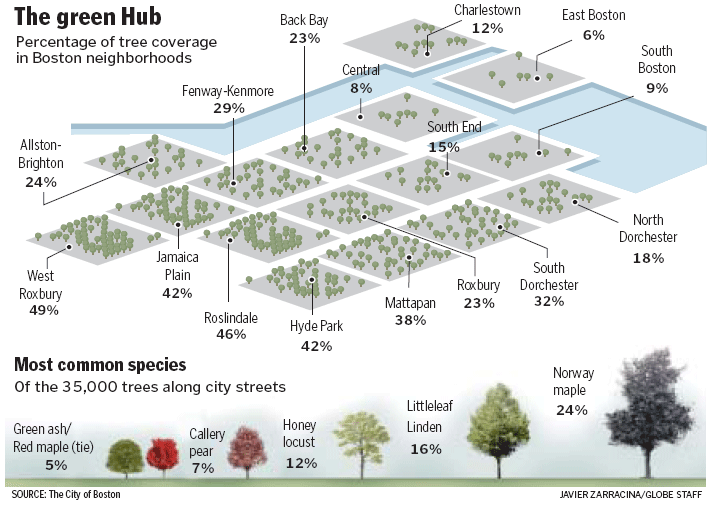A plan takes root: City to plant more than 100,000 trees
Teams up with Forest Service to study benefits for residents
By Jenna Russell, Globe Staff | April 28, 2007
Boston will plant 100,000 trees during the next 13 years, with the bulk of the plantings to take root in the city's least green neighborhoods, Mayor Thomas M. Menino will announce today.
By expanding the urban forest by some 20 percent to cover more than one - third of the city, leaders hope to reap a range of benefits, including cooler temperatures in summer, absorption of carbon dioxide and storm water runoff, and increased psychological well-being among residents.
As part of the initiative, the mayor will also announce a new partnership with the US Forest Service that designates Boston as an urban experimental forest -- one of three such sites in the country -- where scientists and arborists will conduct research to document the effects of trees on people and the environment.
"There's no downside to having more trees," Menino said in an interview. "They bring people together and give people pride in their neighborhood."
The push to increase the tree cover in the city reflects growing national awareness of the value of urban trees, after decades when their potential to help cities address environmental problems was little considered. The project began with a comprehensive inventory of the trees in Boston, conducted by the city and private organizations over three years and completed last fall. Among the inventory's findings: The tree canopy covers 29 percent of Boston, more than several other major East Coast cities.
Tree cover varies widely: West Roxbury, the city's leafiest neighborhood, is almost half-covered by canopy, while South and East Boston each have coverage of less than 10 percent. Officials say the planting of 100,000 trees will bring the proportion citywide to 35 percent by 2020.
The program, expected to cost about $15 million , will be paid for with city, state, federal, and private money, said officials. The goal is for most of the trees to be planted on private property and paid for by private foundations, corporations, and developers.
Menino has proposed spending $500,000 next year to plant street trees. The cost of all the street tree plantings is an estimated $2.5 million. The state Department of Conservation and Recreation has committed $600,000 over the next decade to plant trees on its properties, which make up half the open space in the city, and will pitch in an additional $200,000 to help pay for plantings on private property, said James Hunt, environmental services chief for the city .
The inventory that was completed last fall found that Boston has about 500,000 trees, including those along streets -- trees counted by hand by some 300 volunteers -- and those in open spaces such as parks and college campuses, which were counted using aerial photography. The census includes public and private land.
In Baltimore and New York City , where similar surveys have been done, trees cover 20 percent and 25 percent of the cities, respectively. New York's mayor, Michael R. Bloomberg recently announced a plan to plant a million trees in the next decade; New York City has about 5 million trees .
Environmental benefits are among the biggest reasons for the surging interest in tree-planting, specialists said. Trees remove pollutants from the air and cool urban neighborhoods by absorbing heat and providing shade. They absorb storm water that would otherwise run into city sewers. They have also been linked in some studies to lower rates of health problems among the residents living near them. And because they ab sorb carbon dioxide, believed to be the main culprit in climate change, they are seen as a way to help offset carbon em issions.
"Trees take in greenhouse gases -- that's what trees do," said Michael T. Raines, director of the Northern Research Station of the US Forest Service, which will oversee Boston's experimental forest. "If we manage the trees carefully, we can probably impact 10 percent of the climate change problem."
Future research will look for links between crime rates and the percentage of tree canopy in Boston neighborhoods; if they find correlations , researchers will then dig deeper to identify possible reasons.
The Boston inventory, conducted by a collection of government agencies and non profit groups known as the Urban Forest Coalition, included some surprises: Researchers expected to find some 50,000 trees along public streets in Boston, but the tally was only 35,000. Three-quarters of the street trees were in good health.
Acknowledging that trees on privately owned land and in large green spaces tend to be healthier than street trees, city officials plan to partner with private institutions and individuals in order to plant many of the trees on private land. The city plans to set up a website where residents can request trees to plant on their properties ; trees will be provided to those who agree to care for them , said Hunt .
As part of the effort, officials are planning a program to award carbon emission-offset credits to residents and businesses that plant trees or contribute money.
The tree-planting, originally scheduled to kick off on Arbor Day yesterday but delayed by bad weather, will begin today with a ceremony in Geneva Cliffs, a 2-acre green space in Dorchester. Officials expect to plant 2,000 trees this year, including in empty tree pits along city streets. The city hopes to plant more than 10,000 trees annually from 2013 to 2015; the number will then drop back to 2,000 by 2020.

